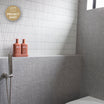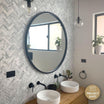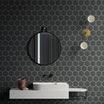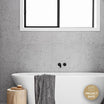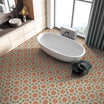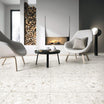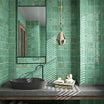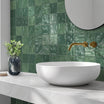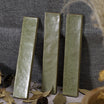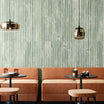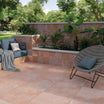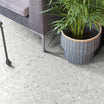Tile Guide
V Ratings
Modern manufacturing techniques, like digital printing, allow tile ranges to replicate the natural variations found in materials such as stone or timber. These tiles can have multiple faces, showing differences in tone, texture, pattern, and color. To assist designers in understanding the expected variation within a tile range, the V Rating scale is applied.
These ratings are provided to help you understand the level of variation you can expect. For tiles rated V2 or higher, you’ll notice distinct differences in color, texture, or pattern between individual pieces. The higher the rating, the more noticeable the variation.
Tiles with V3 and V4 ratings show the most variation, but all categories have some degree of difference. It's important to review your tiles before installation to ensure you’re comfortable with the variation.
The tiles are very uniform, monochromatic in colour, with little or no variation.
The tiles are of uniform appearance, with minimal differences among pieces from the same production run.
V2: Moderate Variation
There are clearly distinguishable differences in tiles of the same colour - in tone, texture and pattern, from tile to tile in the range.![]()
V3: High Variation
There is considerable variation in tiles of the same colour - in tone, texture and pattern, from tile to tile in the range.![]()
V4: Random Variation
A combination of different colours and a high variation in tone texture and pattern, from tile to tile in the range.![]()
Slip Ratings
Slip ratings in tiles are essential for determining their suitability and safety in various environments, particularly when it comes to preventing slips and falls in wet conditions. There are two main systems used to evaluate slip resistance: the P Rating and the R Rating.
P Rating
This measures slip resistance using the wet pendulum test, between P0 to P5, with higher P values indicating better slip resistance in wet conditions.
| Pendulum Classification | Skid Resistance Value [SRV] | Slip Risk |
| P0 | Below 12 | Very high |
| P1 | 12-24 | Very high |
| P2 | 25-34 | High |
| P3 | 35-44 | Moderate |
| P4 | 45-54 | Low |
| P5 | Over 54 | Very Low |
R Rating
Commonly used in commercial settings, this Oil-Wet Ramp Test rating measures slip resistance by laying the tiles on a ramp and applying lubricating oil to the surface of them. It ranges from R9 (least slip-resistant) to R13 (most slip-resistant), with higher values offering greater slip resistance.
| Slip Resistance Value | Corrected Mean Acceptance Angle (Degrees) | Slip Risk |
| R9 | 6-10 | Very high |
| R10 | 10-19 | High |
| R11 | 19-27 | Moderate |
| R12 | 27-35 | Low |
| R13 | Over 35 | Very low |
Slip Rating Requirements
The required slip rating varies depending on whether the tile is intended for residential or commercial use.
For residential settings:
- Bathrooms and kitchens typically require a P3 or R10 rating to ensure safety when the surfaces are wet.
- In living areas or bedrooms, which are less prone to water exposure, a lower rating like P1 or R9 is generally sufficient.
In commercial settings:
- Restaurants and commercial kitchens require high slip resistance, often needing tiles with a P4-P5 or R12-R13 rating due to frequent wet conditions and high foot traffic.
- Retail spaces and office lobbies tend to use tiles with a P3 or R10 rating, striking a balance between appearance and sufficient slip resistance for moderate traffic.
| THE SLIP RATING REQUIREMENTS – TABLE 3B – SA HB 198:2014 | ||
| LOCATION | WET PENDULUM TEST | OIL-WET INCLINING PLATFORM TEST |
| STAIR TREADS, STAIRS & Landings- TABLES-3A D.T.S BCA APPLICATIONS | ||
| Stair Treads and a Stairway Landings- (Nosings Pendulum only) – DRY | P3 | R10 |
| Stair Treads and a Stairway Landings- (Nosings Pendulum only) – WET | P4 | R11 |
| RAMPS TABLE – 3A D.T.S BCA APPLICATIONS | ||
| Ramps not steeper than 1:14 gradient – DRY | P3 | R11 |
| Ramps not steeper than 1:14 gradient – WET | P4 | R11 |
| HOTELS, OFFICES, PUBLIC BUILDINGS, SCHOOLS AND KINDERGARTENS | ||
| Entry foyers hotel, office, public buildings and internal lift lobbies – WET | P3 | R10 |
| Entry foyers hotel, office, public buildings and internal lift lobbies – TRANSITIONAL | P2 | R9 |
| Entry foyers hotel, office, public buildings and internal lift lobbies – DRY | P1 | R9 |
| Toilet facilities in office, hotels, shopping centres | P3 | R10 |
| Hotel apartment bathrooms, ensuites and toilets | P2 | A |
| Hotel apartment kitchens and laundries | P2 | R9 |
| SUPERMARKETS AND SHOPPING CENTRES | ||
| Fast food outlets, buffet food servery areas, food courts and fast food dining areas in shopping centres | P3 | R10 |
| Shop and supermarket fresh fruit and vegetable areas | P3 | R10 |
| Shop entry areas with external entrances | P3 | R10 |
| Supermarket aisles (except fresh food areas) | P1 | R9 |
| Other separate shops inside shopping centres – WET | P3 | R10 |
| Other separate shops inside shopping centres – DRY | P1 | R9 |
| LOADING DOCKS, COMMERCIAL KITCHENS, COLD STORES, SERVING AREAS | ||
| Loading docks under cover and commercial kitchens | P5 | R12 |
| Serving areas behind bars in public hotels and clubs, cold stores & freezer | P4 | R11 |
| SWIMMING POOLS AND SPORTING FACILITIES | ||
| Swimming pool ramps and stairs leading to water | P5 | C |
| Swimming pool ramps surrounds and communal shower rooms | P4 | B |
| Communal changing rooms | P3 | A |
| Undercover concourse areas of sports stadiums | P3 | R10 |
| HOSPITALS & AGED CARE FACILITIES | ||
| Bathrooms and ensuites in hospitals and aged care facilities | P3 | B |
| Wards and corridors in hospital and aged care facilities | P2 | R9 |






